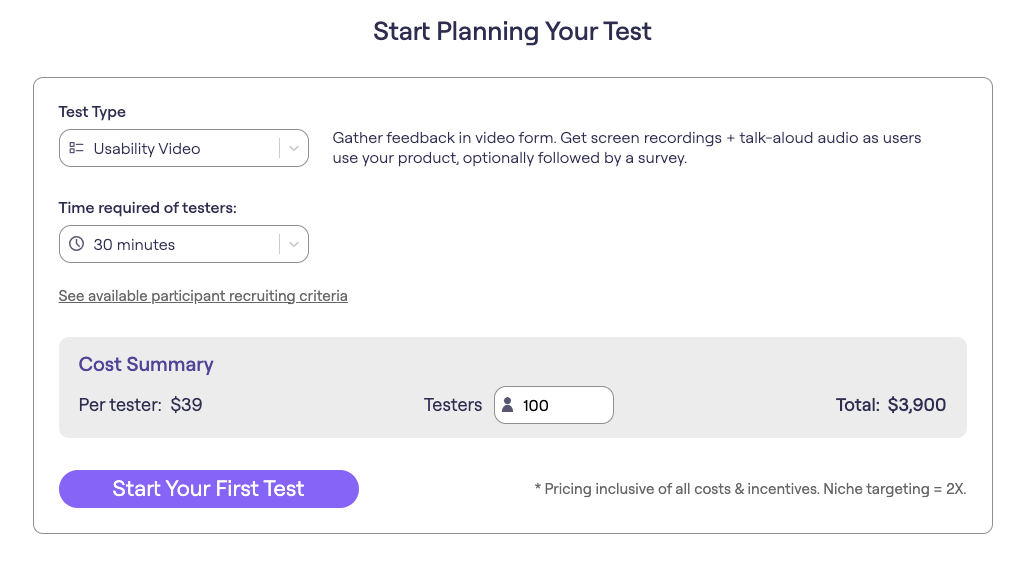11 App Marketing Costs and Stats Unveiled in 2025 (With 30-Step Blueprint)

Have you heard of the cocktail party effect? It’s a cognitive process where you can focus on one conversation in a noisy room, tuning out the background chatter.
I encountered this concept in Alex Hormozi’s book $100M Leads. Akin to advertising, it refers to capturing attention and standing out in a crowded environment, particularly in marketing and ads.
It’s definitely challenging to do that these days given that you have just 8 seconds to capture your user’s attention in a noisy, information-rich environment. So, make every second count.
You need a concrete app marketing plan to stand out in a crowded app marketplace. Unsurprisingly, 95% of 1,000 interviewed app marketers are going beyond the traditional channels as they explore new platforms like podcasts and audio channels, native ad platforms, and online communities.

Source: The Drum
So, let’s crunch some numbers and stats as I unveil a comprehensive breakdown of mobile app marketing costs. It includes each stage of your mobile app, from pre-launch to post-launch, to help you map out a strategy that will sustain you in the long haul.
How much does app marketing cost?
- Market research and analysis: $4,500 to $19,900
- App Store Optimization (ASO): $99 per month; $10,000 to $40,000 per year
- App beta testing: $3,900 to $14,000
- App public relations outreach: $100 – 300/hr; $2,000 – $5,000/mo; $20,000 – $50,000/mo
- Influencer marketing: $1,000 to $10,000 (basic to mid-tier); $10,000 to $500,000 (comprehensive) per year
- Viral marketing: Free; varies on your campaigns and plans
- Social media: $0.51 per click and $8.77 per 1,000 views
- Website: $9.99 per month on website builder; $120 upfront costs $6,000 or more; $1,000 ongoing costs annually or more
- Cost per install: $1.5 to $5.00
- Cost per action: $18.00 – $72.18
- Push notification platforms: $9 to $1,200 per month
1. Market research and analysis: $4,500 to $19,900
App market research involves gathering, analyzing, and interpreting information about your product and customers. It includes understanding the target market, competitors, industry, and current trends.
This knowledge is necessary to make informed decisions about your mobile app advertising and marketing strategies. Research-backed decisions ensure that every dollar spent on marketing yields revenue.
💡 I explored BetaTesting pricing plans and discovered that market research costs can range from $4,500 to $19,900, depending on the complexity and scope of your data collection. This is just one service provider I checked for marketing research costs. I am sure you will find other cheaper options if you have a lean budget. 
Source: BetaTesting.com
If you want to conduct a 60-minute research survey, one interviewee will cost you $45, whereas if you wish to conduct an in-depth interview with 100 testers for 90 minutes, you can pay $19,900. 
Source: BetaTesting.com
💡 As mentioned earlier, this is just one of the many providers that offer market research. I use their pricing plans to give you an idea of how much you’ll pay initially if you choose this route.
How do you market research an app?
The cost of market research can vary depending on the data you want to collect and the amount of time and effort involved. Either way, you can go for primary or secondary research to get started.
| Aspect | Primary Research | Secondary Research |
|---|---|---|
| Description | Collecting targeted original data through interviews, polls, A/B testing, focus groups, and personal interactions | Leveraging existing data sources such as industry reports, competitor analysis, and market trends |
| Example | A survey form for fitness enthusiasts and gym buffs when building a fitness app | Data from quality research sources like Statista, McKinsey and Company, and Insider Intelligence |
| Objective | Evaluate market demand and create effective app marketing strategies | Gain a deeper understanding of the broader market context and insights into industry trends |
| Advantages | Targeted and specific to the needs of the research question | Comprehensive and often more cost-effective than primary research |
| Disadvantages | Time-consuming and costly | May not be as tailored or specific to your particular needs |
💡 Based on my observation and what I’ve discovered, app market research may seem like a significant investment. But remember, the insights you glean will help you better understand your app users’ needs, pain points, and challenges.
You’ll also know which platform they use, whether Android or iOS. Once you know their preferences, you need to consider the next section to ensure your visibility on app stores.
2. App Store Optimization (ASO): From $99 per month and $10,000 to $40,000 per year
App Store Optimization (ASO) involves optimizing your app to rank higher in the app store’s search results. The goal is to increase the app downloads organically. It’s often compared to search engine optimization (SEO), but the strategies are tailor-made for mobile app stores like Google Play Store, Apple App Store, and Microsoft Store.
The cost for ASO services is up to $1,000 per month, while ASO tools have prices of about $20,000 to $40,000 per year for a more comprehensive package.
ASO pricing varies depending on several factors, such as the app store, competition, target market, and the level of optimization needed. It also depends on your chosen medium or approach, as in the examples below.
| Approach | Description | Cost | Advantage | Disadvantage |
|---|---|---|---|---|
| In-house expertise | Doing in-house ASO can be free if you have the skills and resources. | Free (if skills and resources are available) | Cost-effective, complete control | Time-consuming, requires an intricate understanding of ASO |
| ASO tools | Tools can be either free or offered through subscription plans. | – Annual: $2,000 to $40,000 – Monthly: $99 to $659 |
Access to specialized features, scalable | Free tools may have limited functionalities |
| ASO agencies | Provides comprehensive and professional support. | $1,000 to over $10,000 per month | Professional expertise, tailored strategies | Can be expensive depending on the package |
| Dedicated app growth manager | Full-scale support from an app growth manager with tools for app tracking. | $879 per month or $9,679 per year | Dedicated oversight, access to tracking tools | Added costs, may overlap with existing team roles |
1. In-house expertise: Free and cheaper but demands more time
Doing in-house ASO can be free if you have the skills and resources. However, it demands a substantial time investment and an intricate grasp of ASO strategies and tactics. It’s kind of like leaning toward a more do-it-yourself approach.
2. ASO tools: Efficient but costly for comprehensive suites
These tools can be free or offered through subscription plans for an annual cost ranging from $20,00 to $40,000, like Sensor Tower. For monthly plans, around $99 to $659 per month if you look at AppTweak as your reference. 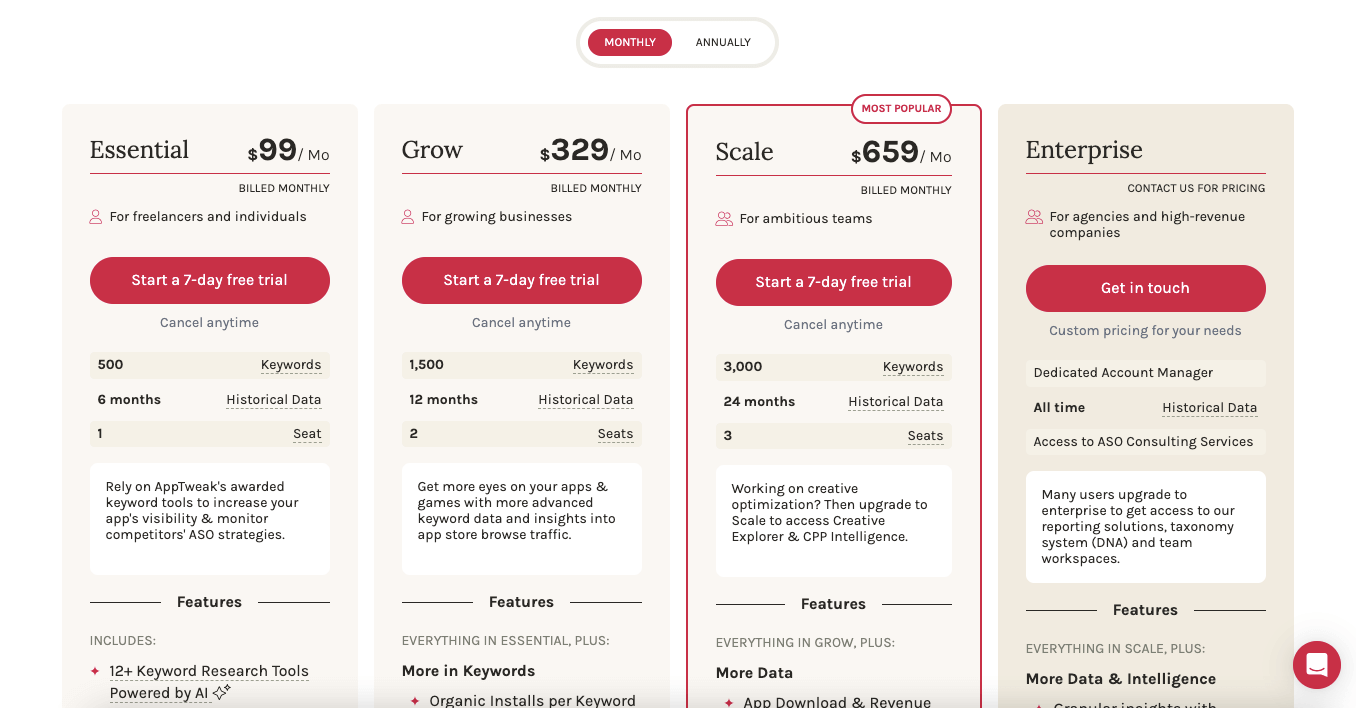
Source: AppTweak
These are just ballpark estimates. Actual costs vary with other tools and service providers. Free tools may have limited functionalities compared to their paid counterparts.
3. ASO agencies: Convenient and with full support from the team
Engaging the services of an ASO agency brings comprehensive and professional support to your goals. Monthly rates for ASO agency services can range from $1,000 to over $10,000, depending on whether it’s a basic, advanced, or comprehensive package.
4. Dedicated app growth manager: Specialized support for your needs
For large teams and companies, consider working with an app growth manager from an agency on a full scale. It will cost you about $879 per month or $9,679 per year, including access to app tracking tools. 
Source: Mobilemoxie.com
ASO is necessary if you aim to drive more app downloads consistently and exponentially. Otherwise, your app will likely get lost among millions of other mobile apps in the app stores.
💡In my opinion, ASO agencies can definitely deliver comprehensive packages with reliable results. But they are expensive. If you have extra funds, you can leverage their core services to get you started and go big quickly. But if you’re starting out and want to stay lean, there are other ways to promote your app—even if it’s not yet developed.
For example, André of Good Empire took this dream to the crowdfunding site Birchal. With the amazing concept and the Appetiser prototype design in hand, Good Empire has gone on to inspire over a thousand like-minded investors to take action of their own. So far, the startup has raised over $1 million without a need for any app development. 
Read Good Empire’s app success story and be inspired by how a dream can become a reality with a growth partner on their side.
3. App beta testing: $3,900 to $14,000
During app beta testing, a nearly finished product is released to a group of selected users in a real-world environment. The goal is to uncover bugs, usability issues, and other problems missed in earlier stages of development.
Beta testers, who represent the product’s target audience, use the software in real-world scenarios to provide feedback on its app performance, functionality, and overall user experience.
External beta testing costs vary, but I found these rates on BetaTesting site for your reference.
Single-session beta test: $59 per beta tester for 90 minutes (100 users) = $5,900
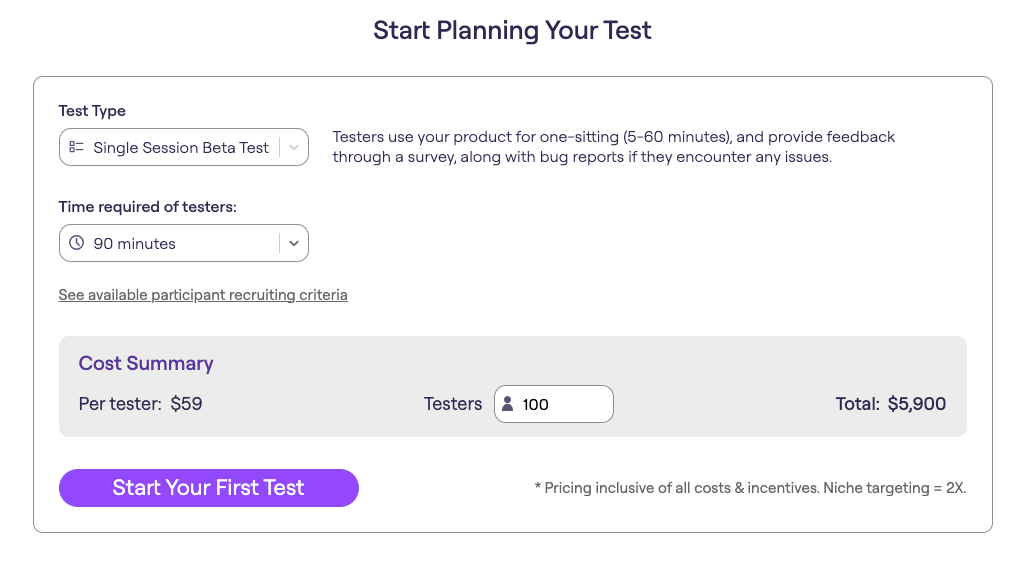
Source: BetaTesting.com
Multi-day test: $140 per tester for 90 minutes in 1 week (100 users) = $14,000
Source: BetaTesting.com
Bug hunt tester: $59 per bug for 90 minutes (100 users) = $5,900
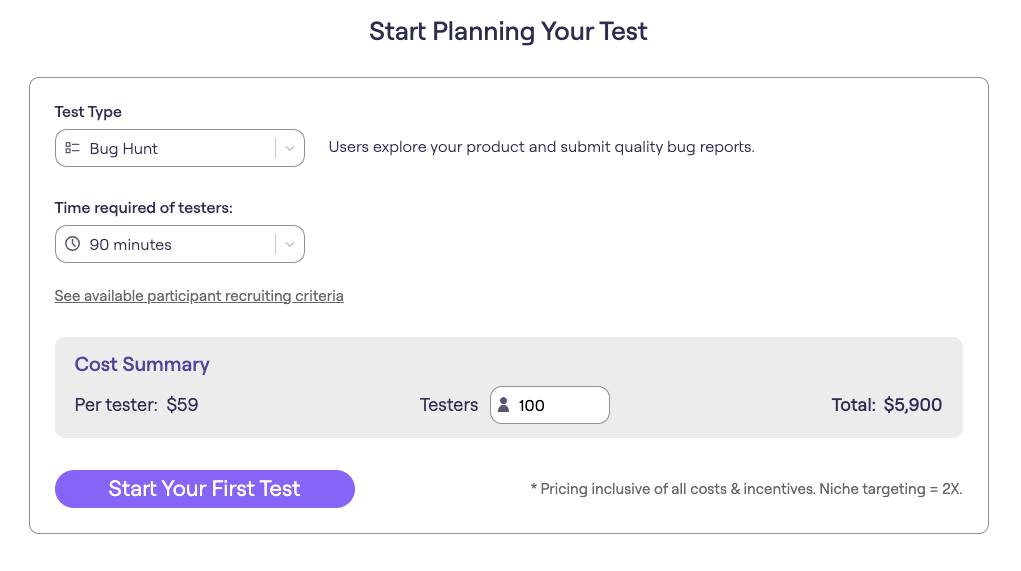
Source: BetaTesting.com
Usability video: $39 per tester for 30 minutes (100 users) = $3,900
Source: BetaTesting.com
While these beta testing rates are based on BetaTesting pricing, you can also find other affordable options—and better yet, free of charge.
Some testing providers offer free services, but you may not receive in-depth user feedback.
Here are a few platforms and sites to check if you choose this route:
- Beta Family. A crowd-testing community for iOS and Android app beta testing. The platform connects you with real users who provide honest, invaluable feedback on the user experience.
- TestFairy. A mobile beta testing platform compatible with iOS and Android. After you upload your APK, the platform allows you to export your mailing list and send them an invitation to test your app.
- Beta directories. A beta testing platform serves as a conduit for real users to experience a product within a production environment before its official release. Submitting your app on, Betabound and Beta Family can help you find beta testers.
- Social media. Facebook, Twitter, and LinkedIn are among the many social platforms that can help you connect with potential beta testers. You can also use relevant hashtags or join groups related to your product to attract testers.
- Personal network. Using your existing group of close contacts is a highly effective method for finding beta testers. Start by reaching out to friends and family, who can provide honest feedback and are more likely to be willing to test your product. Willing testers could produce more insights that could improve your app.
- Online communities. Online communities like Reddit and Quora are great places to find beta testers. To attract potential testers, you can post about your app in relevant threads or answer questions related to your app.
Of course, paid services provide higher quality assurance, so expect more comprehensive feedback.
4. App public relations outreach: $100 – $300 per hour or $2,000 to $50,000 monthly retainer fee
App PR outreach costs refer to the expenses associated with hiring a PR or marketing agency to pitch your app to online publications via press releases, direct communication, and other channels. This strategy enhances visibility among your target audience, bolsters credibility, and creates a buzz.
App PR outreach costs $100 – $300 per hour, depending on the project scope. Meanwhile, be ready to shell out about $2,000 – $5,000 on a low-tier marketing agency. Top-notch firms cost about $20,000 – $50,000 for their monthly retainer fee.
These are estimates. Actual costs vary depending on the services that agencies offer to drive more awareness, which ideally will result in more app downloads.
Here are some of the most common PR initiatives and what they do to promote your app:
- Press releases. Draft and circulate press releases to announce app launches or essential updates. These releases specifically target relevant media outlets, aiming to generate excitement and raise awareness for the mobile app.
- Influencer partnerships. Frequently team up with influential content creators with a sizable and engaged audience that aligns with the app’s target market. These partnerships encompass various collaborations, including organic social media endorsements, user-generated content for advertising campaigns, and sponsored blog posts.
- Blogger and publication outreach. Connect with bloggers, publications, and influencers to secure honest reviews and valuable backlinks. Partnering with a professional backlink agency can further streamline this process, ensuring high-quality placements that enhance app visibility while adding a sense of credibility.
- Content marketing. Develop a solid content marketing strategy to build awareness and trust with the target audience. This could involve creating blog posts, articles, and videos highlighting the app’s features and the problems it solves.
Your team can take care of these initiatives. However, with gargantuan tasks that ideally should be done simultaneously, having an extra set of hands will drive your campaigns to the next level if you allot a budget for app promotion assets costs. To make this scalable, it’s important to streamline budgeting across teams so resources are allocated efficiently without delays or overspending.
If you already have a name out there, like Australian ballet star like Claudia Dean, you have an edge when it comes to promoting your app. What’s amazing about Claudia Dean is that her passion drove her to become a startup founder, making an impact in the ballet community.
Claudia’s vision of helping others achieve greatness found its champion in Appetiser. We crafted an app that not only looked stunning but delivered a seamless user experience, embodying her ideals.

Using our in-house baseplate, we sped up development and launched a ballet training app that became an instant success. Within the first week, it trended, garnered 10,000 downloads, and earned over 200 glowing reviews on the Apple’s App Store with a 4.9-star rating.
💡 In my opinion, a great mobile app that users love and a vision beyond profits trump any promotional campaign. While PR is important, if your product fits the market and solves a real problem, users will naturally become your best marketers.
5. Influencer marketing: $1,000 – $10,000 basic to mid tier; $10,000 up to $500,000 comprehensive per year
Partnering with influencers—individuals with substantial social media followings—can be a game-changer for marketing your app. Through sponsored posts or content, these influencers can reach a highly engaged and targeted audience who are interested in what your app offers.
Influencer marketing costs depend on the influencer’s reach, engagement rate, and platform, but roughly, you can work with an influencer from basic to mid-ter campaigns at $1,000 to $10,000 and for comprehensive ones, from $10,000 up to $500,000 a year
Here’s a breakdown of cost based on the type of influencer I found from Fivver:

Source: Fiverr.com
When enlisting the help of influencers, make sure to select the right ones who align with your brand values and can endorse your app genuinely, establish credibility, and generate buzz. Any misalignment between your influencer and app could make your marketing campaign less effective.
The cost of influencer marketing is substantially high, but influencer endorsements drive higher sales and conversion rates.
- Statistics show that 61% of consumers trust influencer recommendations, surpassing the 38% who trust brand-produced content.
- And even 60% of surveyed marketers believed that influencer marketing is better than traditional advertising.
Here are some of the influencers and ambassadors who were “influential” in making apps go viral:
- Pokémon Go leveraged influencer marketing, collaborating with renowned YouTubers MatPat and Ali-A. This calculated strategy generated a whirlwind of excitement and anticipation, resulting in unprecedented downloads and revenue.
Source: YouTube
- HelloFresh app launched a campaign called “#RefreshWithHelloFresh” in 2019 in collaboration with 15 micro-influencers and the celebrity Davina McCall. The campaign was aimed at the UK market and involved a 21-day challenge where the influencers tried out various HelloFresh recipes.
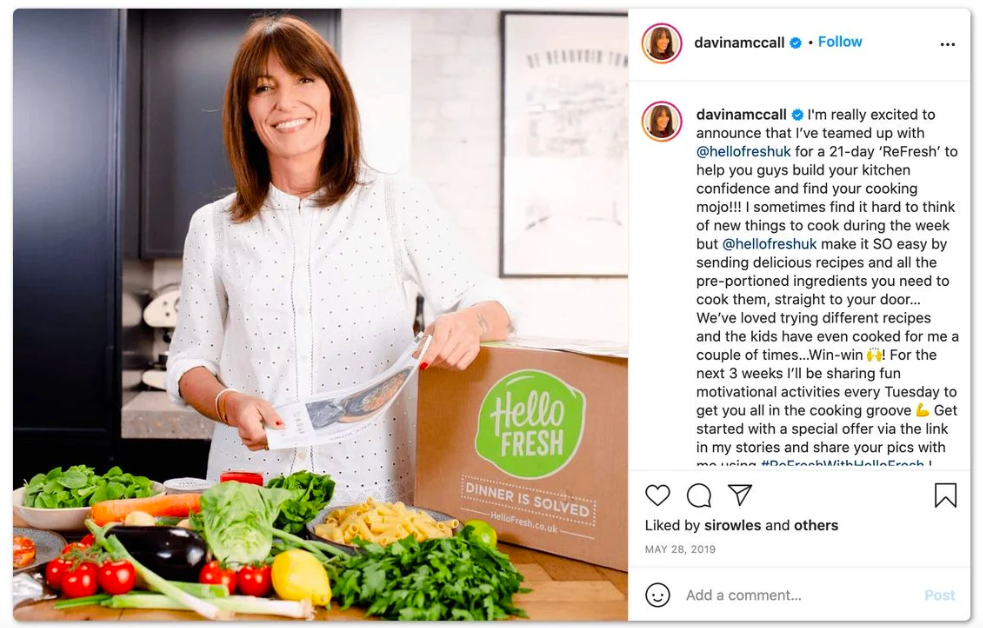
Source: Heepsy
Overall, influencer marketing is shaping the future of advertising, and 59.4% of brands are willing to allocate more budget in the next 12 months.
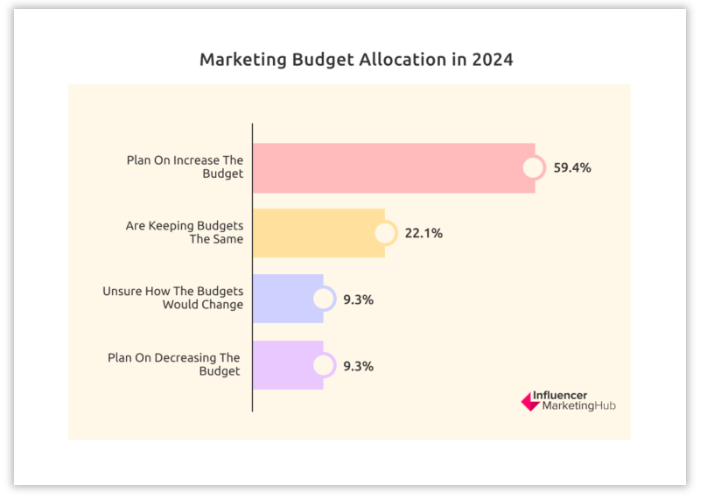 Source: Influencer Marketing Hub
Source: Influencer Marketing Hub
6. Viral marketing costs: Often $0 but can be paid as well
Viral marketing creates a buzz around your app through social media shares, word-of-mouth, and other organic methods.
The goal is to get people talking about your app and sharing it with their networks, which can lead to exponential growth in user acquisition.
Viral marketing costs are generally lower than traditional advertising campaigns, as they rely on consumers sharing the content. There’s no ballpark estimate for this kind of marketing, as it’s free to ignite a viral post.
One of the classic viral marketing stories is Dropbox. Before launching, Dropbox created a landing page that captured 70,000 email signups in just one day of their private beta.
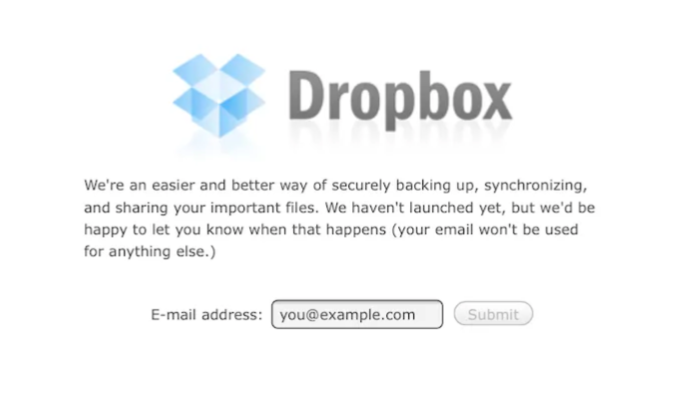
Get the latest industry news first.
Source: Bootcamp UX Design
They also use a referral program, offering extra storage to both referrer and new users, sparking exponential growth. This strategy led to a staggering 3900% user increase in just 15 months.
You can double the efforts and results with paid social media advertisements like Facebook, Instagram, or YouTube ads. The amount may vary, depending on the channel you use.
7. Social media and other app promo assets: $0.63 per click and $9.78 per 1,000 impressions
Social media and other app promo assets include Facebook, Instagram, LinkedIn, YouTube, and other channels.
App promotion assets refer to the materials you need to promote your apps, such as videos, creatives, screenshots, icons, and app descriptions. All these are set to drum up buzz and attract users.
A basic social media presence might not cost anything at all. But running highly targeted ad campaigns can quickly rack up expenses.
Roughly, the average cost of Facebook ads in 2025 is $0.51 per click and $8.77 per 1,000 views.
The cost is lower than last year’s records, at $0.94 per click and $12.07 per 1,000 impressions, respectively, giving advertisers like you more opportunity to maximize your budget.
These days, it’s cheaper to advertise on Facebook. But you also need to consider other channels like Instagram, YouTube, and TikTok, to name a few, depending on where your target audience is regularly hanging out.
Pinch, one of our app development projects, is the ultimate event-planning and memory-keeping app. You can seamlessly capture, create, and share photos and videos, turning them into cohesive stories.
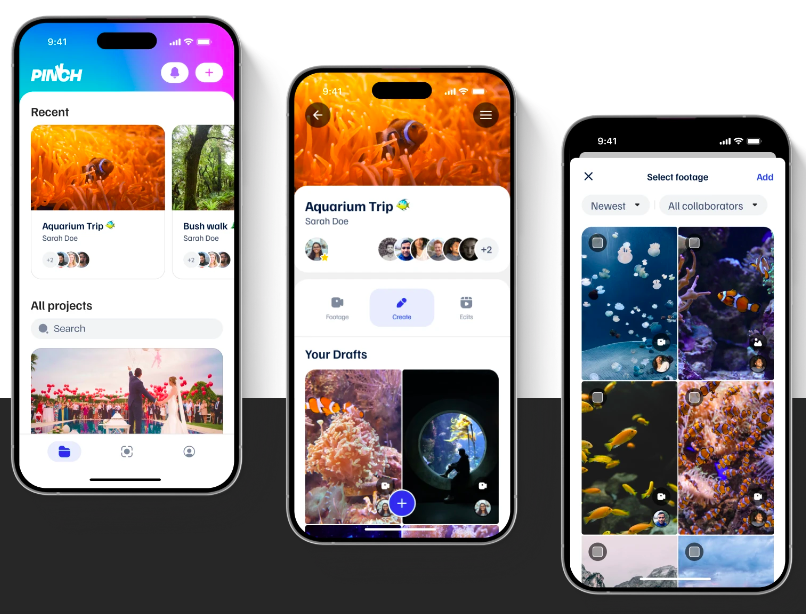
The Pinch team is taking a unique approach to social media, taking advantage of short-form videos on TikTok, sharing app features, memes, and everything in between in a creative and entertaining way.
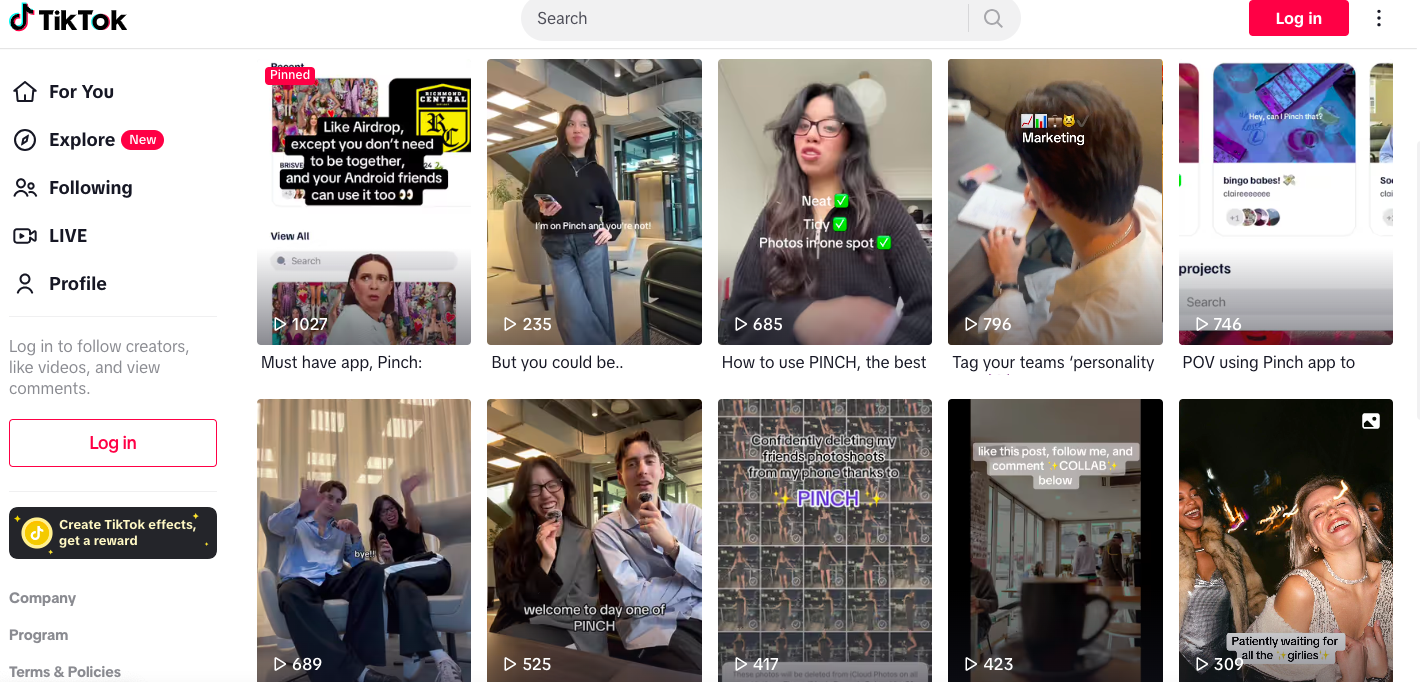
Source: TikTok
Videos aren’t just a trend—they’re a game changer. Integrating them into your marketing will forge deeper connections with your audience.
Pinch shows exactly how impactful video content can be, boosting the app’s presence and creating community. One truth stands out: the future is video.
Read this further for a handful of video marketing strategies for business to guide you in crafting videos for app promotions.
8. Website: $9.99 per month; developers and designers from $6,000
A website acts as your mobile app’s virtual storefront, allowing potential users to explore its features, benefits, and aesthetic appeal. It is a platform to showcase the user interface, captivating and enticing potential users.
You can build one in two ways: website builder and custom website development.
A website builder offers a significant advantage: the ability to quickly and affordably create a professional website, even without coding or programming expertise. If you’re starting lean, you can go for a decent website builder that will cost $9.99 per month billed annually, a custom domain name is not yet included.
Expect to pay more than $120 upfront and $10 monthly to maintain a website with a limited budget. Domains usually cost around $8 for the first year, but some providers require upfront payment for the first two to three years to get the discounted price.
With custom web development, the price is quite higher than the former. Hiring designers or app developers could raise the upfront cost starting from $6,000 or more, with an ongoing cost of $1,000 annually or more.
Once all these elements in the pre-launch stage have been established, it’s high time to consider the next stage: app launch. You release your app to the world, and in the post-launch stage, you promote and maintain its growth.
Now, let us delve into a crucial facet of app marketing costs in the next round.
9. Cost-per-install: $1.5 to $5.00
Cost-per-install, or CPI, is a vital metric for marketers. It measures the effectiveness of paid advertisements in acquiring new app users and complements the Average Revenue per User (ARPU) to ensure the revenue exceeds acquisition costs.
Cost per install varies by country, platform, and ad unit, as seen below. The data are sourced from Business of Apps.
| Category | CPI range ($) |
|---|---|
| iOS CPI Globally | $1.5 to $3.5 |
| Android CPI Globally | $1.5 to $4.00 |
In my observation, despite Android users’ low purchasing power, it naturally leads to more competitive advertising and, consequently, higher CPIs. Meanwhile, iOS’s stringent review process on apps and strict privacy regulations stack up higher acquisition costs globally.
Speaking of globally, here are the CPI by location, ranging from $1.50 to $5.00 max:
| Mobile app CPI by location | CPI range ($) |
|---|---|
| APAC | $1.5 to $3.00 |
| EMEA | $2.00 to $4.00 |
| Latin America | $0.50 to $2.00 |
| North America | $2.5 to $5.00 |
My two cents and thoughts are: the high Cost Per Install (CPI) in North America is more than just a number—it’s a reflection of the region’s unique economic landscape and consumer behavior.
You can’t overlook the higher purchasing power of North American users. These consumers are willing to spend on premium apps and in-app purchases and expect top-tier quality and functionality. This expectation drives app developers to invest heavily in user acquisition, leading to fierce competition and, inevitably, higher CPI.
Next, the advanced mobile app ecosystem in North America sets a high bar for app quality and innovation. Developers know that only the most polished and engaging apps will thrive in such a competitive market. This reality pushes them to allocate substantial budgets to marketing efforts, further inflating CPI.

Calculating CPI is straightforward: divide your total ad spend by the number of installs. For instance, if you invested $10,000 in mobile ads and gained 3,500 installs, your campaign’s CPI would be $2.85. It’s feasible to give a rough estimate of the marketing budget by knowing how much each install costs.
Now, here’s where you need to be critical in your strategy. Although an estimated average cost globally has already been provided (each region has a different CPI), you have full control of how much you want to allocate for ad spending. There’s no one-size-fits-all price point.
Is there an ideal CPI for mobile apps?
No. It depends on how much you’re willing to spend.
But there are key several factors that will influence your efforts and budget.
- 🚀 Device platform. Android and iOS apps differ in their ability to generate CPIs. Research suggests that Apple users worldwide exhibit a greater propensity to spend on in-app purchases than Google users, resulting in a higher average cost per install.
- 🚀 Advertising networks. Media sources offer varying advertisement rates. For instance, the CPI on in-app ad networks may differ from that on social media or search channels.
- 🚀 Genre and category. The app’s category and genre greatly impact the overall CPI. Mobile games, for instance, typically exhibit higher CPIs than other app categories. Additionally, specific gaming genres, such as social casino game apps, can command above-average CPI—worldwide, it’s at $7.31.
- 🚀 Geographic location. The CPI price may vary based on the country. The socio-economic standard of the population can influence the price, with more affluent countries typically having a higher cost.
- 🚀 Ad formats and sizes. Different ad formats, such as banners, interstitials, or rewarded videos, can influence the CPI. Some ad formats may be more effective in driving installs, leading to higher costs. For instance, 76% of US gamers prefer rewarded video ads over interstitials, making them the most effective formats.
With these in mind, it’s worth mentioning that CPI isn’t just the only metric you need to make a successful app marketing campaign.
Let’s move on to the next cost you need to factor in.
10. Cost-per-action: $18.00 – $72.18
Cost-per-action, or CPA, is an advertising pricing model in which advertisers pay for specific user actions, such as app downloads or service subscriptions. This approach allows app marketers to reduce their expenses, as they only pay for successful conversions.

For example, getting someone to install your app may cost less than getting someone to purchase within your app. Additionally, if you’re in a highly competitive industry, the cost per action may be higher as more bidders are vying for ad space.
Remember that the cost of CPA can vary depending on various factors, including the action itself and the level of competition.
| Category | CPA rate ($) |
|---|---|
| 2023 Purchase Model
(with 10-15% install to action rate) |
$23.20 to $72.18 |
| 2023 Subscription Model
(with 15-20% install to action rate) |
$28.95 to $63.28 |
| 2023 APAC Purchase Model | $24.84 to $40.00 |
| 2023 APAC Subscription Model | $30.42 to $48.13 |
| 2023 EMEA Purchase Model | $40.44 to $50.57 |
| 2023 EMEA Subscription Model | $35.45 to $52.47 |
| 2023 LATAM Purchase Model | $23.20 |
| 2023 LATAM Subscription Model | $28.95 |
| 2023 NAR Purchase Model | $62.58 to $72.18 |
| 2023 NAR Subscription Model | $54.16 to $63.28 |
| 2023 Facebook Ads Cost Per Action Rate | $18 to $30 |
| 2023 Google Ads Cost Per Action Rate | $30 to $50 |
Source: Business of Apps
The data above provides clear insights for app monetization and advertising strategies.
Here’s a streamlined breakdown of the trends and their implications:
Purchase vs. subscription models
- 💡 The CPA rates for purchase models range from $23.20 to $72.18, while subscription models range from $28.95 to $63.28. This indicates that gaining a new user for a subscription model is generally more cost-effective than gaining a new user for a purchase model, though both fall within similar ranges.
- 💡 Interestingly, the install-to-action rate is higher for subscription models (15-20%) than for purchase models (10-15%). This suggests that users are more likely to complete the desired action in subscription-based apps, potentially due to ongoing value and app engagement.
Now that I mentioned these, you can read a comprehensive guide on app pricing models to learn which one is best for your app business.
Regional variations
- 💡 APAC. CPA rates for the purchase model are $24.84 to $40.00, and for the subscription model, they are $30.42 to $48.13. The relatively lower CPA rates might reflect a more cost-sensitive market. But there’s definitely a significant opportunity for growth with app localization strategies.
- 💡 EMEA. Purchase model CPA rates range from $40.44 to $50.57, and subscription model rates range from $35.45 to $52.47. This region shows higher costs, indicating a competitive market with users willing to pay for premium services.
- 💡 LATAM. With a fixed CPA rate of $23.20 for purchase models and $28.95 for subscription models, LATAM shows a cost-effective market for user acquisition, albeit with potentially lower spending power.
- 💡 North America (NAR). Purchase model CPA rates range from $62.58 to $72.18, while subscription model rates range from $54.16 to $63.28. The higher costs reflect a mature market with high purchasing power and intense competition.
Advertising platform CPA rates
- 💡 Facebook ads. The CPA rate ranges from $18 to $30, making it a relatively cost-effective platform for user acquisition. Facebook’s extensive targeting capabilities and large user base may contribute to these competitive rates.
- 💡 Google ads. The CPA rate ranges from $30 to $50, indicating a higher cost per action compared to Facebook. But remember, Google Ads’ reach and ability to target users based on search intent can justify the higher expenses.
My key takeaways and tips for maximizing cost per action
1. Choosing the right monetization model
Subscription models not only show higher install-to-action rates but also tend to have competitive CPA rates. This makes them an attractive option for app developers looking to build long-term user relationships and recurring revenue streams.
2. Consider regional strategies
You need to tailor strategies to regional variations in CPA rates. For example, while North America presents higher acquisition costs, the potential for high returns justifies the investment. Conversely, regions like LATAM offer lower costs, making them ideal for scaling user bases if you want to get a piece of the market.
3. Think of the ad platform that matches user preferences
The choice of advertising platforms should align with budget constraints and your target users. Facebook ads offer relatively lower CPA rates, though you’ll be entering a competitive ad space. However, they can be advantageous for reaching a broader audience at a lower cost.
This product-led growth strategy explains a different approach and will be an eye-opener for you if you’re looking for a more comprehensive approach to expanding your reach.
Now, let’s move on to another cost factor in app marketing: push notifications platforms.
11. Push notification platforms cost: $9 to $1,200 per month or more
A push notification platform allows you to send targeted notifications to your app users, even when they’re not actively using it.
These notifications can be personalized, such as sending a message to a user who has left items in their cart or promoting a sale based on their previous purchase history. They can also be general, such as notifying all users of a new app update or introducing a new feature.
The costs of the push notification platforms vary depending on the number of users, API access, and advanced features. Service providers charge you monthly rates, ranging from $9 to $1,200.
Here are some of the platforms and providers I’ve come across that offer those price points, from the cheapest to the most expensive ones billed monthly:
- OneSignal. This platform offers a Growth Plan at $9 per month. It supports both web and mobile push notifications and in-app messaging, and the Professional Plan is $99 per month.
- PushEngage. The paid plans start at $19 monthly for up to 50,000 subscribers. The free plan supports up to 200 subscribers.
- PushAssist. This platform offers a Starter Plan for $9 per month and a Business Plan for $25 per month.
- Pusher. The most expensive is the Growth Plus which costs $1,199 per month and includes up to 90 million messages pushed per day. Pusher also offers custom pricing for enterprise customers who require more advanced features and support.
Push notifications are crucial in keeping users engaged and connected to your app. When properly executed, they have the potential to enhance customer retention by 20%, and when timed optimally, they can boost retention rates by up to sevenfold.
For a deeper dive into this topic, read our article on push notifications and their advantages.
So now you know how much app marketing will cost you and the team.
You may also need to convince key people to allocate a budget for it. The next section gives you solid data to justify your recommendations and action items for your mobile app marketing strategies.
Why should you have an app marketing budget?
Having an app without a mobile app marketing budget is like having a nice Porsche without fuel.
It’s impossible to move forward. If you’ve invested time and resources in app development costs, it’s vital to allocate funds for marketing, too.
Think about this: there are over 8.93 million apps available for download. Without a dedicated budget for mobile app marketing, your app will go unnoticed.

With a solid mobile app marketing budget, you can:
- ✅ Target your mobile app promotion exclusively to your desired audience. This encompasses various strategies such as social media ads, pay-per-click campaigns, influencer marketing, and more.
- ✅ Deep dive into analytics and measurement tools to track your app’s performance. You can continually optimize your app marketing campaign or strategy and drive better results by measuring key metrics like retention rate, user engagement, and lifetime value.
- ✅ Experiment with different marketing channels and tactics. By trying out new strategies, even possibly working with an app marketing agency, you continually refine your approach and maximize your app ROI over time.
Overall, with budgeted app marketing costs, you can spread out your financial resources in three stages: pre-launch, launch, and post-launch.
For these stages, a holistic approach is needed to implement strategies that will drive results. Now, there’s a better way to do that.
Create your product growth strategy with us
If you’re ready to launch an awesome app—budgeting and planning out your app marketing strategy beforehand can give you great returns.
Crafting the ideal growth plan for your mobile application is vital as it clarifies how far-reaching your business growth should be.
To achieve this, Appetiser offers a comprehensive approach to mapping out the ideal growth strategy of your iOS, Android, and web apps, from ideation to post-launch.
The success stories of our clients, like Claudia Dean, Good Empire, and Pinch, showcase how having the right app development partner can take you from zero to greater heights. Even those I didn’t mention, such as Youfoodz, MyDeal, and Vello, have one asset in common—their collaboration with Appetiser.
Whether it’s shaping your strategy for market entry or developing a perfect multi-device experience, we’re your partners in success.
Just give us a call, and leave the rest to us. With Appetiser Apps, you’re not just launching an app; you’re building a future.
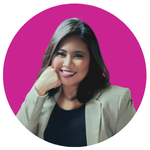
Maria Krisette Lim is a Content Marketing Specialist with 14 years of experience producing web and print ad content. Krisette has a BSBA degree, major in Business Management and Entrepreneurship. When she’s not tinkering with words and punctuation, she’s either curled up with a book while sipping hot tea, playing with her toddler, or tinkering with website builders.
Get the latest industry news first.



